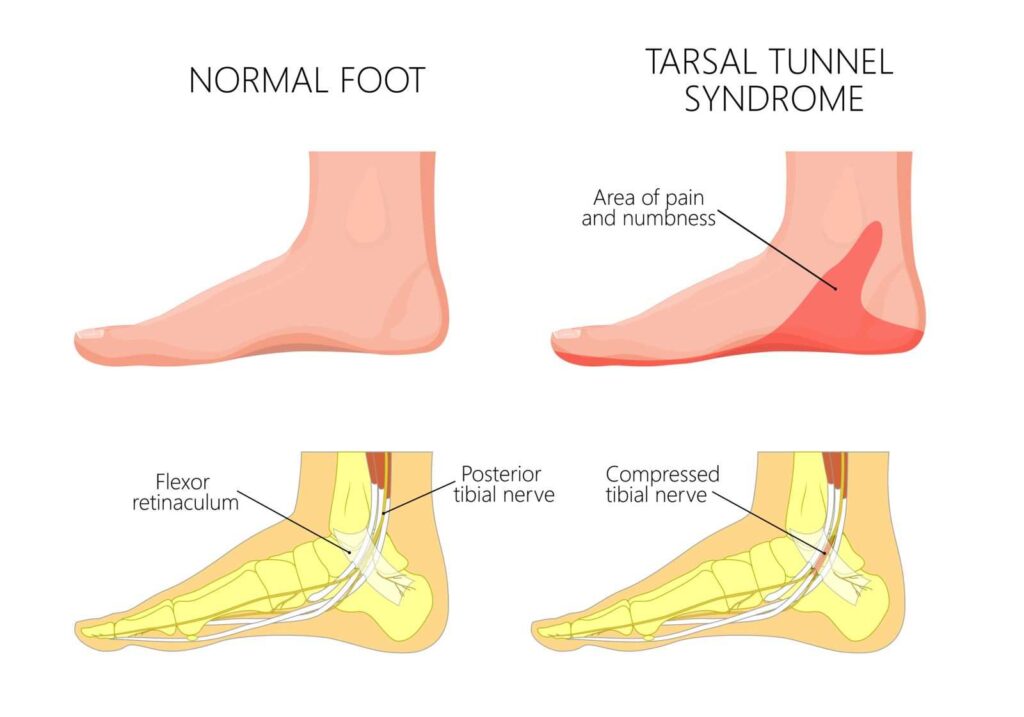Tarsal Tunnel Syndrome
What Is Tarsal Tunnel Syndrome?
Tarsal tunnel syndrome is a condition where one of the key nerves running along the inside of your leg and ankle, called the posterior tibial nerve, becomes trapped and compressed, leading to painful symptoms.
The tarsal tunnel, named after the tarsal bones surrounding your ankle, is a narrow passage between the bones on the inside of your ankle and the soft tissues that support it. This tunnel houses the posterior tibial nerve, which branches off to provide sensation to parts of your feet. When the tunnel narrows, the nerve becomes pinched and compressed, resulting in tarsal tunnel syndrome.

Table of Contents
Who Is At Risk Of Tarsal Tunnel Syndrome & Why?
Tarsal tunnel syndrome has many potential causes, similar to how various factors can lead to a sore stomach. Anyone can develop this condition, and the causes range from ankle injuries and swelling pressing on the nerve to the development of cysts or foot posture issues. Sports activities that put strain on the ankle can also lead to swelling, damage, or bone spurs. Medical conditions like arthritis, which cause inflammation in the ankle joints, can also contribute. In some cases, no specific cause is found.
Since the compression affects a nerve, symptoms include pain along with neural sensations like tingling, burning, pins and needles, and numbness in the heel and bottom of the foot. Symptoms may vary depending on foot and ankle positioning, as this affects the space in the tunnel. Reducing swelling can help lessen the severity of symptoms.
Visit Us Today
Hope Island
Phone: 07 5510 9222
Located within Hope Island Marketplace Medical & Skin Clinic, 99-103 Broadwater Ave Hope Island QLD 4212
Jimboomba
Phone: 07 5546 9766
Located Within Jimboomba Medical Centre, Unit 1/69 Cerina Cct, Jimboomba QLD 4280
Beenleigh
Phone: 07 3287 2224
Located Within Beenleigh Mall Medical Centre, Shop24A, 40/68 Main Street, Beenleigh QLD 4207
Eagleby
Phone: 07 2889 1666
Located Within Eagleby Family Practice, 5/120 River Hills Rd, Eagleby QLD 4207
Harristown
Phone: 07 4635 6111
Located Within Toowoomba Medical Centre, 146 Drayton Road, Harristown QLD 4350
Marsden
Phone: 07 3067 2370
Located Within Marsden Family Doctors, Shop 28/55-77 Chambers Flat Rd, Marsden QLD 4132
Keperra
Phone: 07 3355 4082
Located Within Keperra Medical Clinic, 14 Dallas Parade Keperra QLD 4054
Coomera
Phone: 07 5573 5663
Located Within Doctors @ Coomera Central, Shop 6, 21 Coomera Grand Drive, Upper Coomera, QLD 4209
Newtown
Phone: 07 4633 8700
Located Within Ochre Medical Centre Wyalla, Shop 20, 238 Taylor Street, Newtown QLD 4350
Treating Tarsal Tunnel Pain
First Steps
To treat tarsal tunnel pain effectively, it’s important to address the underlying cause. While ice, compression, elevation, and anti-inflammatory medications can provide temporary relief for inflammation, they won’t help if a cyst or bone spur is present in the tunnel. Start by resting your foot and avoiding activities that trigger the pain.
See Your Podiatrist
Proper care for tarsal tunnel pain is crucial to prevent long-term nerve damage. At Priority Podiatry Clinic, we begin with a comprehensive biomechanical assessment to identify the cause of the nerve compression and determine the best treatment approach. This may involve custom foot orthotics to help open the tunnel and address any structural or functional issues, such as flat feet, contributing to the compression.
If swelling from an injury around the ankle is causing the pressure, we’ll manage this injury while relieving the nerve compression symptoms. Our goal is to help you feel better now and reduce the risk of the issue recurring in the future.
We’ll also ensure your footwear supports your recovery and doesn’t aggravate your symptoms. Once you’re ready, we may recommend stretching, strengthening, or gait retraining if muscle weakness, tightness, or gait issues have contributed to the problem.
Enquire Now
Not The Condition You Are Looking For?
Find out more about the conditions we treat by clicking below.
